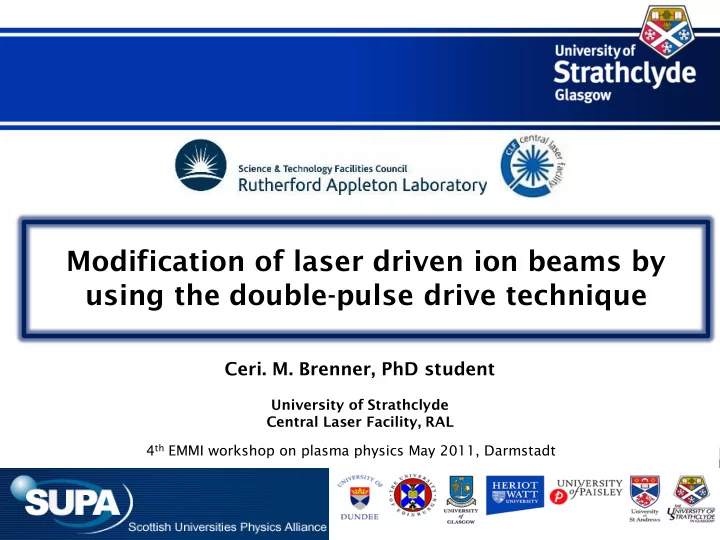

Modification of laser driven ion beams by using the double-pulse drive technique Ceri. M. Brenner, PhD student University of Strathclyde Central Laser Facility, RAL 4 th EMMI workshop on plasma physics May 2011, Darmstadt
Ion acceleration driven by a double-pulse drive configuration How is it useful? What is it? How does it work? Experimental results
Laser-plasma accelerators Compact, bright sources of: • High energy electrons • Gamma rays • XUV and x-ray radiation • Ions
Applications E p > ~ 100 MeV Ion beam cancer therapy Proton probing (field measurements) Radiography (density measurements) Injection into conventional accelerators Production of isotopes Fast ignition fusion Proton heating Industrial (lithography) E p ~ 10 MeV
Applications E p > ~ 100 MeV Ion beam cancer therapy Proton probing (field measurements) Radiography (density measurements) High flux of medium energy (3-15 MeV) Injection into conventional protons accelerators Production of isotopes Fast ignition fusion Proton heating Industrial (lithography) E p ~ 10 MeV
Double pulse mechanism Ponderomotive electron Target Normal Sheath acceleration Acceleration (TNSA) plasma Electron sheath - + - - + + + - - + + + - + - + + + - - + - + Protons (and other ions) (a) (b) (c) time
Multi-Pulse Sheath Acceleration (MPSA) “Spectral control in proton acceleration with multiple laser pulses” , A.P.L.Robinson et al, Plasma Phys. Control. Fusion 49 (2007) 373 – 384 Vlasov PIC Proton energy (MeV) Proton energy (MeV) single drive pulse double drive pulse
Multi-Pulse Sheath Acceleration (MPSA) p p /m p c p p /m p c • controlled initial pulse initiates TNSA of ions and protons • density modulation of protons builds up ahead carbon front • increase in T e caused by 2 nd (main) drive pulse • surge of higher energy protons across ion front • high accelerating fields at ion/proton boundary
“Spectral enhancement in the double pulse regime of laser proton acceleration”, K.Markey et al, PRL, 105, 195008, (2010) 1 0.1:1 x3.3 enhancement Conversion efficiency (%) ratio 0.1 x2.5 enhancement 0.4:1 ratio 0.01 0 1 2 3 Pulse delay (ps) 100 µm Au foils, Vulcan Petawatt, high contrast (with plasma mirror)
1D PIC simulations t = t 0 -250fs • Protons • Ions
1D PIC simulations t = t 0 -150fs • Protons • Ions
1D PIC simulations t = t 0 -50fs • Protons • Ions
1D PIC simulations t = t 0 +50fs • Protons • Ions
1D PIC simulations t = t 0 +150fs • Protons • Ions
1D PIC simulations t = t 0 +250fs • Protons • Ions
1D PIC simulations t = t 0 +350fs • Protons • Ions Surge
Analysis in progress, not yet publishable
Recirculation and multi pulses? 100 µm
Recirculation and multi pulses? L For L < τ L c/2 where L is 120 μ m for τ L ~ 800 fs 5 µm Recirculation of electrons
Calibrated radiochromic film (RCF) stack I L1 ~ 3.2 x 10 18 W/cm 2 I L ~ 3.2 x 10 19 W/cm 2 and 45 ° I L2 ~ 2.9 x 10 19 W/cm 2 1.2 No prepulse Intensity (a.u.) 1 0.1:1, 1.5 ps 0.8 0.6 0.4 0.2 0 -3 -2 -1 0 1 Time (ps)
Using thin foils to enhance conversion efficiency • 5 µm Au foils • Vulcan Petawatt • high contrast • ~180 J on target
Using thin foils to enhance conversion efficiency > x 100 increase • 5 µm Au foils Analysis in progress, • Vulcan Petawatt • high contrast not yet publishable • ~180 J on target
Development of MPSA technique Spectral enhancement using the double pulse technique demonstrating: • significant flux enhancement in the thin foil (refluxing) regime for lower energy protons • increase in laser-to-proton conversion efficiency compared to thicker foils Analysis in progress, not yet publishable
Development of MPSA technique Spectral enhancement using the double pulse technique demonstrating: • significant proton flux enhancement in the thin foil (refluxing) regime for lower energy protons • increase in laser-to-proton conversion efficiency compared to thicker foils Future direction: • investigate the double pulse technique for ultrashort laser system parameters • conduct 2D PIC simulations to study the evolution of the sheath field on the rear surface
Strathclyde : C.M. Brenner , R.J. Gray, G. Scott, P. Mckenna CLF, RAL : R.H.H. Scott, K. Markey , K.L. Lancaster, D. Neely , P.A. Norreys, I.O. Musgrave, A.P.L. Robinson, J.S. Green, M. Notley, Vulcan laser staff and CLF target fabrication teams GSI, Darmstadt : O. Deppert, M. Roth IPPLM, Poland : M. Rosinski, J. Badziak, J. Wolowski LULI : H.P. Schlenvoigt, S.D. Baton CELIA : C. Beaucourt, J.J. Santos York : J. Pasley IST Lisbon : K. Li, J.R. Davies TEI, Crete : S.M. Hassan, E. Clarke, M. Tatarakis DFO, Milan: D. Batani Thank you
Recommend
More recommend